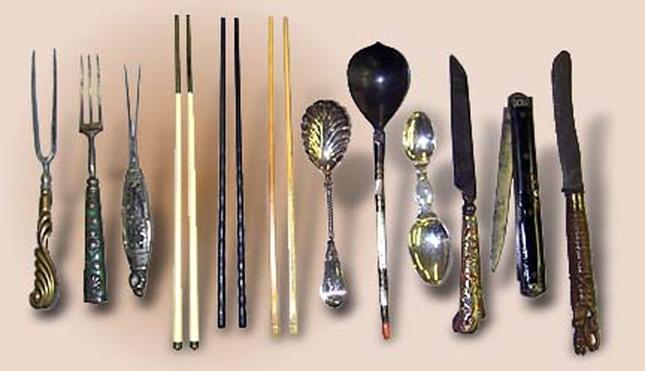The Utensils: From Eating to Dining
By • January 11, 2016 0 17185

Early Americans were close to medieval in their dining habits. Even though people have been sharing communal meals with their families and friends from the beginning of civilization, early meals in Colonial America were more a matter of crude survival.
Most foods in the colony-building 17th century consisted of one-pot dishes like stews, porridges and puddings, meals that are suited for cooking over an open fire. Tableware and dining utensils were scarce; hence, meals were eaten from shared utensils, bowls and wooden cups, called noggins, passed from mouth to mouth. Although using communal tableware was borne of necessity, it was also customary, as the Puritan ethic espoused frugality and simplicity. It was related that a newcomer to one New England town brought individual trenchers for each member of his family and was admonished by the town magistrates for being too extravagant.
A typical family ate off trenchers, a 10- or 12-inch rectangular block of wood about three inches thick with a bowl shape carved into it. After the main course, the trencher was turned over and dessert was served on the clean side. A poor, rural family might eat from a trencher that was actually a table of sorts made from a long block of wood with a “V” shaped trough cut through the center into which the stew was poured and shared by all. Some families dispensed with trenchers altogether, and ate “spoon meat,” roasted meat served on thick slices of bread.
Prior to the American Revolution, most Americans ate with spoons made from shell, horn, wood or gourds. Sharp knives, also used as weapons, were initially used less to cut meat, than to anchor it down while people tore off a piece with their hands and shoved it into their mouths. The blunt-tipped knives imported to the colonies were the precursors to the fork and often food was brought to the mouth on the flat edge of the knife. Until the late 18th century, forks were still uncommon in the colonies and deemed a curiosity. Since the new blunt knives made it difficult to spear food, the two-prong fork was used to hold meat while being cut — but still not so helpful for holding bites of food.
By the middle of the 18th century, early Americans began to acquire more wealth and mass-produced dining utensils were becoming more available and affordable. A sign of refinement was the appearance of individual place settings. The simple fork significantly refined table manners, as hands were no longer used to reach for food and greasy fingers no longer wiped on the tablecloth.
Although forks had been used by the French court as early as the 14th century, they were used only when eating exotic foods or foods that could easily stain the hands. By the 17th century, travelers had spread the word about this eating invention. It became commonplace throughout Europe, but the colonies still refused to use the fork. They looked upon it as an effeminate and useless curiosity. Finally, by the early 19th century, the three- and four-prong forks, developed in England and Germany, were becoming the primary eating utensil in America and marked the real beginning of civilized dining by Americans.
Meanwhile, fewer middle and upper class folk ate from a common serving bowl. Pewter plates began replacing wooden trenchers, and many affluent households did not use woodenware at all. However, people living far out in the newer settlements, away from transportation centers used it for about 200 years. China first made an appearance in the early 18th century, but was found only in wealthier households — and it rarely came out of the china closet.
By the middle of the 19th century, dining in America was not just about eating. Victorians, with their love of making any simple gathering an event, were the first to identify a specific room for dining. They introduced a bewildering assortment of silver flatware, a far cry from the simple knives of their ancestors. There was a specialized utensil for every conceivable use. There was a spoon for cream soup, a special spoon for clear soup, luncheon knives, dinner knives and coffee spoons, dinner spoons,
dessert spoons and so on. There were so many dining accoutrements that it seemed there was scarcely room on the table for the food.
Even though the United States was one of the last regions to adopt spoons and forks, we still tuck into great fried chicken using our most efficient eating tools — those located on the ends of our arms.
Michelle Galler (antiques.and.whimsies@gmail.com) is an antiques dealer, design consultant and realtor based in Georgetown. Her shop is in Rare Finds, in Washington, Virginia.

